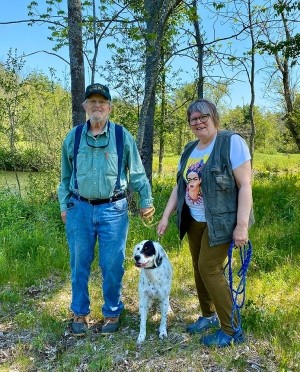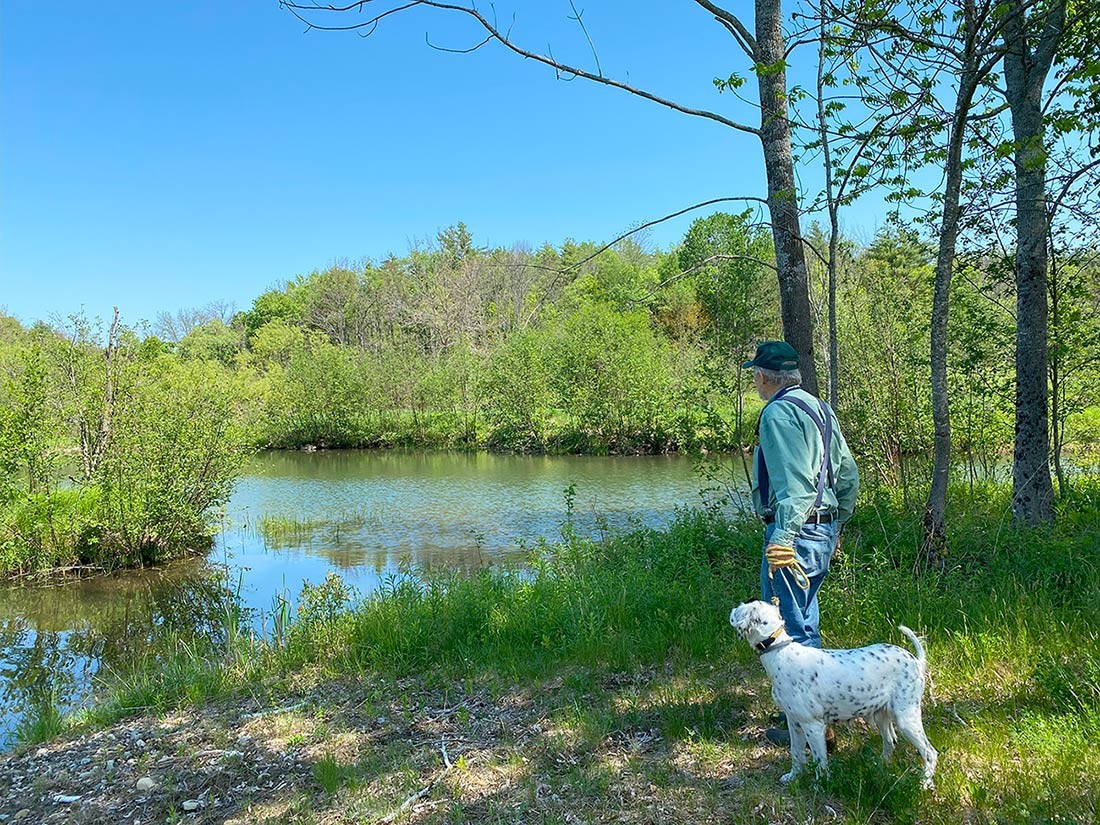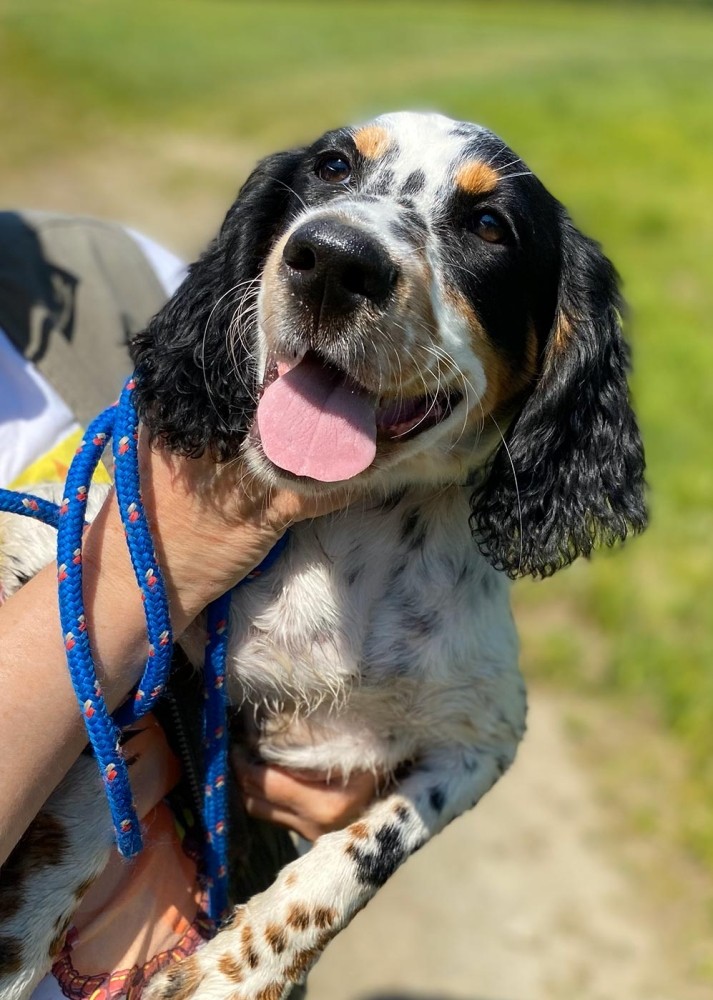When Jim Kennedy moved about five years ago to a new property in Hanover, New Hampshire, just down the road from where he’d lived for more than four decades, he set to work – eradicating invasive honeysuckle and Japanese knotweed, building a wildlife pond, and implementing a staggered mowing regime for the field, in part to improve habitat for various wild species, including woodcock. While Jim doesn’t hunt much these days, he has long been fascinated with woodcock, and still works with his wife Deb to train their English setters for field competitions. A landscape architect and certified wetlands scientist, Jim is mostly retired now – including from his time on the Hanover Conservation Commission – although he continues to work on his own 35 acres and on other conservation projects, and he teaches classes on wetlands through Dartmouth’s Osher Lifelong Learning Institute.
I was out in the woods all the time when I was a kid. I grew up in Chappaqua, New York, where Hillary Clinton lives. I used to hunt in back of Hillary’s house. Don’t try to hunt there now – you can’t even go near the place! Secret Service all over the place. Chappaqua is built up now, but in those days, I could hunt all morning without seeing a house. I’d go out hunting squirrels and rabbits and grouse. I saw my first woodcock when I was 13 years old, and I’ve been fascinated ever since.
My father wanted me to go to the Naval Academy. My mother wanted me to go to Dartmouth or Middlebury or someplace like that. But I wanted to go to forestry school, so I did. I went to what was then called the New York State College of Forestry at Syracuse – now it’s SUNY Environmental Science and Forestry. We had to take all these basic courses in the first year – dendrology and botany and zoology. Then they let us choose which major we wanted to go into – pulp and paper, wood processing, forestry. There were these guys up on the top floor studying landscape architecture, and there were all these drawings.
I love to draw, and I love to walk in the woods – landscape architecture was perfect, and that’s what I got my degree in. After college, I spent two years in the Army. Then I spent four years apprenticing in various different offices, then I got my landscape architect license in New York. I moved to Hanover, New Hampshire, to Hanover Center Road, and I continued to practice landscape architecture. Most of it was in land planning. I did a lot of golf courses and condominiums and shopping centers. Locally, I helped design the Powerhouse Mall in Lebanon, and the Village at Dartmouth College Highway in Lyme. I did all the master planning for Bretton Woods for 15 years. Golf courses, ski areas, condominiums, commercial areas – you name it. I had an office in Lyme, and for a while, I had four people working for me. Then I started taking on less development work, and more conservation projects.
Eventually, I got certified as a wetlands scientist, and that got me started on the path of getting wetlands permits and specializing in ponds. I’m now 83, and mostly retired. I don’t do development work anymore. I want to do conservation work and habitat management. And I like to play around here improving our new property.
When I moved to New Hampshire, I had 60 acres of un-managed land on Hanover Center Road. I created different habitats – a pond, vernal pool, early successional habitat, and woodcock openings. There’s a beautiful trail system all the way around. I did a lot of work up there, and I created a Management and Stewardship Plan that shows a history of what was done –and what can be done – divided into management areas. We sold it to Bear Hill Conservancy Trust with the idea that eventually it would go to some kind of protection monitored by Fish and Game. Half of it is under easement to New Hampshire Fish and Game. Part of the other half is under easement to the federal government, USDA.
Hewes Brook is a new place for me. My wife Deb and I have lived here for 5 years. I started working on the property about 8 years ago, doing wetland assessment and planning for our new home. We have 35 acres, and it is a mixture of habitats. It’s different than the old place. It’s got better soils. It’s got this whole flood plain dynamic. We have a pond and a vernal pool, and Hewes Brook flows through. There’s rich mesic forest and a black ash swamp. I built a wildlife pond. It’s got coves and islands, different depths and different shorelines. We’ve got shallows with cattails and bullrush. There’s a merganser nesting in the box above the pond. We had a heron in here the other day feeding in the shallows. There are turtle logs, positioned downwards so the turtles can come up and bask, then go back into the water again. We had beavers last year. We have otters who come right up the brook. I can look out the window over the meadow and see the pond and all of the wildlife.
I’ve put a lot of effort into removing invasive species. The pond site and floodplain were half full of knotweed. First we tried cutting it. Then we tried burning it. Then we tried cutting it and burning it. Eventually we had to give up and use herbicide. And it’s still coming back. I carry a machete. When I see knotweed, I chop it back. There was also a lot of invasive honeysuckle. I hate honeysuckle. The branch structure gets so that nothing grows underneath it. The woodcock, especially, don’t like it. I don’t have any regeneration of sugar maple. The deer pressure is too great, and sugar maple is like candy to them. So I planted some sugar maples in tree tubes, and I’ve been cutting honeysuckle and dropping it and just leaving it. That protects anything coming up from the deer browse.
The field is about 5 acres, and I rotate my mowing. I mow the field once a year in one part and once every two or three years on the other part. I don’t mow until October. The part I don’t cut is my alder, nannyberry, and silky dogwood nursery for the year – I’ll dig them up and plant them in other areas. I think alders are probably some of the best habitat plants. It’s great cover for the woodcock, and it’s nitrogen-fixing. I’ve also planted some plots of warm-season grasses and pollinator plants and milkweed.
This is prime woodcock habitat. It’s wet and has alders, poplar, birch. The woodcock use it for feeding and nesting, and when they migrate in the fall, it’s a great flight cover for warming up and resting between flights as they go south. We hunt woodcock, and we also go to woodcock championships. My wife Deb is a bird dog trainer too. We met training bird dogs. We go to cover dog trials for grouse and woodcock.
I was grouse hunting one time in Chappaqua, and I wasn’t having any luck. This guy comes along with a Brittany, and he was getting a lot of birds pointed. I thought, “I’ve got to get one of them.” I hunted and competed Brittanys for quite a while. Now we have three English setters. I love training and competing with dogs. It allows me and my wife to get out in the woods and to explore different covers.
I really got into the dogs as a way of being out in the woods, being attuned to what habitat is, looking at different covers. We have taken these dogs to Pennsylvania, Michigan, Wisconsin, and New Brunswick. We enjoy it – being with each other, watching the dogs run. It’s a great sport. It’s a good hobby. Deb and I went to field trials this spring, and in the fall we’ll probably go to wild-bird championships.
Once you get to a certain age, hunting changes. I’ve heard it said that the hunter is the learner, then he’s the efficient harvester, then he’s the conservationist. I had my many years of shooting a lot of birds. Now I don’t anymore, but Deb and I train together all the time. We’re out in the woods together, just with blank guns, and we still go to competitions where you don’t kill birds. We also learn about habitats and get to see an awful lot of different places.





Discussion *